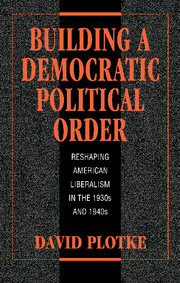Book contents
- Frontmatter
- Contents
- Preface
- Introduction: The Democratic order as a political project
- 1 When does politics change?
- 2 Creating political orders: the logic of the Democratic experience
- 3 Democratic opportunities in the crises of the 1930s
- 4 Passing the Wagner Act and building a new Democratic state
- 5 Party and movements in the Democratic upsurge, 1935–7
- 6 Progressive liberalism as pragmatic common sense
- 7 Surprising years: electing Truman and sustaining the Democratic order, 1947–9
- 8 Passing Taft-Hartley: what the losers won (and what the winners lost)
- 9 New political fronts? growth and civil rights in the 1940s
- 10 Democratic anti-Communism and the Cold War
- 11 From Truman to Kennedy: the reach and limits of Democratic power
- 12 Was the Democratic order democratic?
- Index
3 - Democratic opportunities in the crises of the 1930s
Published online by Cambridge University Press: 17 September 2009
- Frontmatter
- Contents
- Preface
- Introduction: The Democratic order as a political project
- 1 When does politics change?
- 2 Creating political orders: the logic of the Democratic experience
- 3 Democratic opportunities in the crises of the 1930s
- 4 Passing the Wagner Act and building a new Democratic state
- 5 Party and movements in the Democratic upsurge, 1935–7
- 6 Progressive liberalism as pragmatic common sense
- 7 Surprising years: electing Truman and sustaining the Democratic order, 1947–9
- 8 Passing Taft-Hartley: what the losers won (and what the winners lost)
- 9 New political fronts? growth and civil rights in the 1940s
- 10 Democratic anti-Communism and the Cold War
- 11 From Truman to Kennedy: the reach and limits of Democratic power
- 12 Was the Democratic order democratic?
- Index
Summary
In 1932 the issue was the restoration of American democracy: and the American people were in a mood to win. They did win. In 1936 the issue is the preservation of their victory. Again they are in a mood to win. Again they will win.
– Franklin Roosevelt, 1936In the 1930s progressive liberals in the Roosevelt administration and Congress allied with new mass political forces to build the Democratic order. They led the way in forming a Democratic political bloc whose elements cut across conventional institutional boundaries and whose themes reshaped American liberalism. The new order entailed an expanding state, a renovated Democratic Party, and new movements and interest groups, most notably the labor movement. It was committed to modernization, efficiency, and moderately egalitarian social and economic reform.
The events and outcomes of the decade are still the subject of lively debates, which are often linked to contemporary political positions. For some, the 1930s (and 1940s) show a healthy politics of interest-aggregating parties. Others argue that a special chance was lost to develop a more aggressively reformist liberalism, perhaps a mass social democratic force. Arguments persist about the labor movement and the decade's radical political movements, as well as about New Deal agricultural policies and racial practices.
- Type
- Chapter
- Information
- Building a Democratic Political OrderReshaping American Liberalism in the 1930s and 1940s, pp. 77 - 91Publisher: Cambridge University PressPrint publication year: 1996



